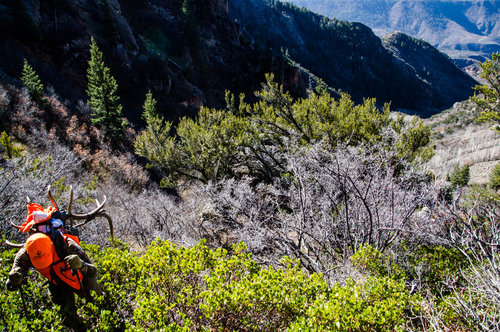I came here last year, read a lot and posted a little - hunted GMU's 77 & 78 during 2nd Rifle, didn't see a single Elk. No biggie, I talked to a few people out in the field and even the experienced hunters said they weren't seeing elk. Theory was that the very high temperatures kept them at the high elevations.
FF to this year, back again. The weather is even warmer - 75* the first three days, it finally cooled down about Tuesday - when I saw my first ever male elk during hunting season - as he walked by my campsite just after I got up No shot though, he was just a spike - did I mention I finally spotted my first elk while hunting
No shot though, he was just a spike - did I mention I finally spotted my first elk while hunting  We also saw 4 cows a couple of days later - so this year was not a complete loss. Funny thing was, we were on a piece of FS land that was posted, but every resource I had showed it as public. We verified with a Game Warden that the land was indeed public - interesting.
We also saw 4 cows a couple of days later - so this year was not a complete loss. Funny thing was, we were on a piece of FS land that was posted, but every resource I had showed it as public. We verified with a Game Warden that the land was indeed public - interesting.
Anyway, finally to the point of my post. I watch Randy and he's got these areas that he can walk into that are public - they might be OTC, they might be draw, doesn't matter - and what I see is that he can get to his areas via logging roads and get to spots where he can glass over long distances; this is one of the things that drew me to elk hunting but what I'm finding is that throughout so much of these 2 GMU's any walking that I want to do is through forests full of downed timber and there just aren't any places where I have greater than 50 (maybe 100) yard 'vistas'.
Are there other parts of the state where I can not hunt in a closed in forest and get a little opportunity to glass a little bit? Or should I be sleuthing my maps better?
P.S. I saw mule deer everywhere and will definitely be applying for a draw tag in these units for next year. I see that 77 has 3:1 mule to elk harvest and about equal in 78. Hopefully some meat will be coming home next year.
FF to this year, back again. The weather is even warmer - 75* the first three days, it finally cooled down about Tuesday - when I saw my first ever male elk during hunting season - as he walked by my campsite just after I got up
Anyway, finally to the point of my post. I watch Randy and he's got these areas that he can walk into that are public - they might be OTC, they might be draw, doesn't matter - and what I see is that he can get to his areas via logging roads and get to spots where he can glass over long distances; this is one of the things that drew me to elk hunting but what I'm finding is that throughout so much of these 2 GMU's any walking that I want to do is through forests full of downed timber and there just aren't any places where I have greater than 50 (maybe 100) yard 'vistas'.
Are there other parts of the state where I can not hunt in a closed in forest and get a little opportunity to glass a little bit? Or should I be sleuthing my maps better?
P.S. I saw mule deer everywhere and will definitely be applying for a draw tag in these units for next year. I see that 77 has 3:1 mule to elk harvest and about equal in 78. Hopefully some meat will be coming home next year.





